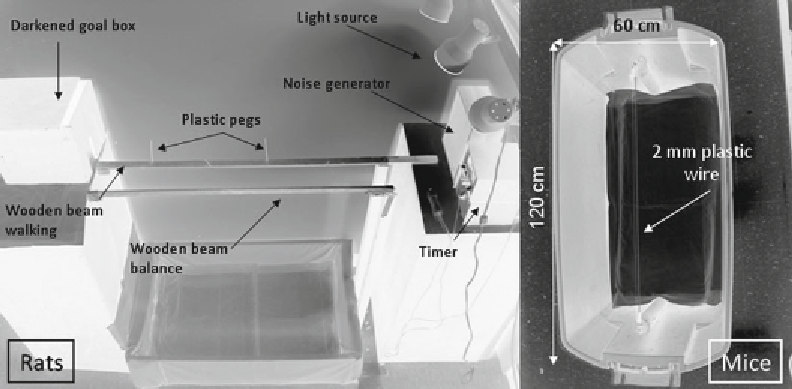Biology Reference
In-Depth Information
Fig. 4
Beam walking and beam balancing equipment used for rats and mice
3.3 Behavioral
Studies
1. Beam Walking Task: The rat is made to walk on a 1-m length
wooden beam that is set at 1 m of height above the ground
(Fig.
4
). It is made to walk from one end of the beam that is
close to the noise source, towards the goal box. A wooden
beam with appropriate width (depends on weight of the rat;
typical width for a 300-350 g rat is 2.5 cm) is selected. The
beam is cleaned with 70% alcohol and allowed to dry between
the trials. A light source that points towards the starting point
is turned on and the room lights are turned off. A typical trial
consists of: (a) turning the timer and resetting it to zero;
(b) holding the timer switch in the nondominant hand with
the thumb on the button; (c) holding the animal by tail with
the preferred (dominant) hand and placing it onto the beam at
progressively increasing lengths from the goal box (fifths of the
way; usually marked on the beam) and simultaneously starting
the timer and noise; (d) once the animal learns to walk the
whole length, trials are repeated till it is able to cross the whole
length for three consecutive trials within 5 s; (e) then the plas-
tic pegs are placed into the holes in the beam at regular inter-
vals alternating from side to side (fifths of total length), within
5 mm along the edge, and the trials are repeated till the animal
is able to cross the entire length within 10 s for three consecu-
tive trials. If both trials are met within a total of 30 trials (with
pegs and without pegs) the animal qualifies for the next day's
trial (the presurgery trial on the day of surgery). The animal is
given rest for 30 s between the trials. On the day of surgery the
trials are repeated and if the animal is able to cross the beam
with pegs within 5 s for three consecutive trials it qualifies for

Search WWH ::

Custom Search